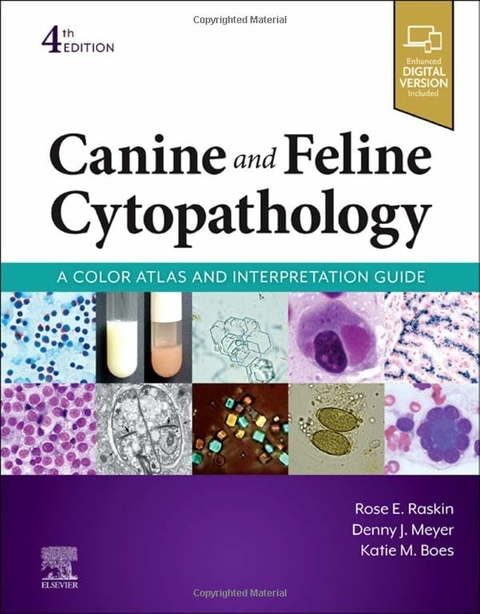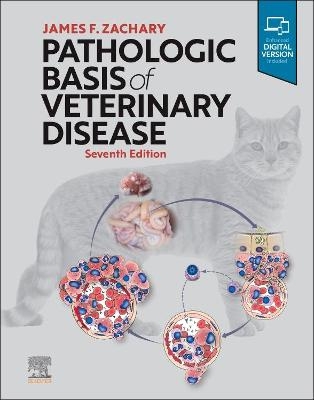
Canine and Feline Cytopathology
Saunders (Verlag)
978-0-323-68368-5 (ISBN)
Comprehensive coverage of all body systems and body fluids emphasizes the application of aspirate biopsy cytopathology for greatest diagnostic impact.
Exceptional-quality, full-color photomicrographs include detailed figure legends.
Helpful hints for improving specimen quality are provided in discussions of common errors and problems, resulting in more diagnostically effective, cost-effective use of cytopathology.
Discussions of clinical findings, differential diagnostic considerations, and the rationale are included for the final cytopathological diagnosis.
Additional photomicrographs in organ system chapters demonstrate the histological or histopathologic corollary of cytopathologic findings.
Easy-to-use, well-organized format includes many tables, algorithms, boxes, and Key Point callouts for at-a-glance reference.
Clear, concise descriptions include sampling techniques, slide preparation and examination, and guidelines for interpretation, leading to accurate in-house and commercial laboratory diagnosis.
Extensively revised organ system-based chapters include focused contemporary references.
NEW! 700 crisp, all-new images more closely match the colors representative of the actual microscopic view.
NEW! Expanded content combines coverage of the exocrine and endocrine pancreas and adds a new emphasis on the ear, specifically otic sample collection and cytopathology.
NEW! All-new appendices provide quick reference to infectious agents, immunocytochemistry, reporting, molecular and immunologic testing, quality assurance, and more.
NEW! Enhanced eBook is included with each new print purchase, providing access to a fully searchable text online - available on a variety of devices.
Chapter 1. Simple Acquistion and Management of Cytology Specimens
A. General Sampling Guideline
B. Diagnostic Imaging-Guided Sample Collection
C. Managing the Cytologic Specimen
D. Staining the Specimen
E. Site-Specific Considerations
F. Submitting Cytology Specimens to a Reference Laboratory
G. References
Chapter 2. General Categories of Cytologic Interpretation
A. Normal Tissue
B. Hyperplastic Tissue
C. Cystic Mass
D. Inflammation or Cellular Infiltrate
E. Response to Tissue Injury
F. Neoplasia
G. Artefacts and Other Questionable Findings
H. References
Chapter 3. Skin and Subcutaneous Tissues
A. Normal Histology and Cytology
B. Normal-Appearing Epithelium
C. Noninfectious Inflammation
D. Infectious Inflammation
E. Parasitic Infestation
F. Epithelial Morphology Neoplasia
G. Mesenchymal Morphology Neoplasia
H. Round or Discrete Cell Morphology Neoplasia
I. Naked Nuclei Morphology Neoplasia
J. Response to Tissue Injury
K. References
Chapter 4. Hemolymphatic System
A. General Cytodiagnostic Groups for Lymphoid Organ Cytology
B. Lymph Nodes
C. Spleen
D. Thymus
E. Extramedullary Hematopoiesis
F. References
Chapter 5. Respiratory Tract
A. The Nasal Cavity
B. Larynx
C. Trachea, Bronchi, and Lungs
D. References
Chapter 6. Body Cavity Effusions
A. Collection Techniques
B. Sample Handling
C. Laboratory Evaluation
D. Normal Cytology and Hyperplasia
E. General Classification of Effusions
F. Specific Inflammatory Types of Effusions
G. Bilious Effusion
H. Chylous Effusion
I. Neoplastic Effusion
J. Hemorrhagic Effusion
K. Parasitic Effusion
L. Pericardial Effusions
M. Miscellaneous Effusion Findings
N. Ancillary Tests
O. References
Chapter 7. Oral Cavity, Gastrointestinal Tract, and Associated Structures
A. Oral Cavity
B. Salivary Gland
C. Esophagus
D. Criteria for Gastrointestinal Cytology
E. Stomach
F. Intestine
G. Colon/Rectum
H. References
Chapter 8. Fecal Cytology
A. Sample Collection and Processing
B. Normal or Incidental Microscopic Findings
C. Abnormal Microscopic Findings
D. References
Chapter 9. Pancreas (Exocrine/Endocrine)
A. Normal Cytology
B. Hyperplasia
C. Inflammation
D. Neoplasia
E. Ancillary Tests
F. References
Chapter 10. Liver and Gall Bladder
A. Sampling the Liver
B. Normal Liver Cytology
C. Normal Gallbladder Cytology
D. Non-Neoplastic Diseases and Disorders
E. Neoplasia
F. References
Chapter 11. Urinary Tract
A. Normal Anatomy and Histology
B. Specialized Collection Techniques
C. Normal Renal Cytology
D. Non-Neoplastic and Benign Lesions of the Urinary Tract
E. Neoplasia
F. References
Chapter 12. Microscopic Examination of the Urinary Sediment
A. Sediment Preparation
B. Microscopic Examination and Recording
C. References
Chapter 13. Reproductive System
A. Mammary Glands
B. Ovaries
C. Uterus
D. Vagina
E. Prostate Gland
F. Testes
G. References
Chapter 14. Musculoskeletal System
A. Normal Joint Anatomy and Synovial Fluid Production
B. Synovial Fluid Evaluation
C. Normal Gallbladder Cytology
D. Musculoskeletal Disorders
E. References
Chapter 15. The Central Nervous System
A. Cerebrospinal Fluid
B. Cytology of Nervous System Tissue
C. Newer Diagnostic Tools and Recent Studies
D. References
Chapter 16. Ocular and Otic Sensory Systems
A. General Cytodiagnostic Groups for Ocular Cytology
B. Cytologic Biopsy Considerations for the Eye and Adnexa
C. Eyelids
D. Conjunctivae
E. Nictitating Membrane
F. Sclera
G. Cornea
H. Iris and Ciliary Body
I. Aqueous Humor
J. Vitreous Body
K. Orbital Cavity
L. Nasolacrimal Apparatus
M. General Cytodiagnostic Groups for Otic Cytology
N. Normal Ear Anatomy and Histology
O. External Ear Canal and Pinna
P. Otitis Media
Q. References
Chapter 17. Endocrine/Neuroendocrine Systems
A. Thyroid Gland
B. Parathyroid Gland
C. Adrenal Gland
D. Chemoreceptor Tumors
E. Carcinoids
F. References
Chapter 18. Advanced Diagnostic Techniques
A. Immunohistochemistry
B. Immunocytochemistry
C. Electron Microscopy
D. Special Histochemical Stains
E. Flow Cytometry
F. PCR for Antigen Receptor Rearrangements
G. Dection of Mutations, Translocations, and Copy Number Variations
H. References
Appendix 1. Microscope Equipment and Proper Usage
A. Microscope Basics
B. Using Polarized Lenses
C. Smartphone Telecytology
Appendix 2. Selected Cytologic Staining Protocols
A. Alkaline Phosphatase Stain
B. Acid-Alcohol Destaining
C. Periodic-Acid Schiff Stain
D. Gram Stain
E. Lipid Stains
F. Immunocytochemical Staining
Appendix 3. Cytologically Confusing Structures and Polarizing Materials
A. Artefactual Findings
B. Normal but Cytologically Confusing Structures
C. Polarizing Substances
Appendix 4. Mitotic Figures and Chromatin Patterns
A. Normal Mitotic Figures
B. Abnormal Mitotic Figures
C. Chromatin Patterns
Appendix 5. Advanced Collection and Preparation Techniques
A. Cell Block
B. Fluid Conversion for Histopathology
C. Cell Transfer
Appendix 6. Composing Cytologic and Histologic Reports
A. Basic cytologic terminology and cytologic report elements
B. Example fluid and solid specimen cytology descriptions
C. Basic histologic terminology and histologic report elements
D. Example infectious and neoplastic histology descriptions
Appendix 7. List of Selected Specialized Testing Sites
A. Calculi identification
B. BRAF mutation for canine bladder cancer
C. C-Kit mutation analysis
D. Endocrine
E. Flow Cytometry
F. Genetic testing for metabolic diseases
G. Immunochemistry
H. Oomycete identification
I. PARR for clonality
J. PCR for infectious agents
Appendix 8. Quick Reference for Morphologic Features of Infectious and Parasitic Agents
A. Bacteria
B. Fungi
C. Protozoa
D. Parasites
Appendix 9. Quality Assurance and Diagnostic Test Reporting
A. Quality assurance guidelines
B. Accuracy and precision related to cytology
C. Validation comparisons
D. Evidence-based cytology in practice
| Erscheinungsdatum | 22.02.2022 |
|---|---|
| Verlagsort | Philadelphia |
| Sprache | englisch |
| Maße | 216 x 276 mm |
| Gewicht | 2200 g |
| Themenwelt | Veterinärmedizin ► Vorklinik |
| Veterinärmedizin ► Kleintier | |
| ISBN-10 | 0-323-68368-1 / 0323683681 |
| ISBN-13 | 978-0-323-68368-5 / 9780323683685 |
| Zustand | Neuware |
| Haben Sie eine Frage zum Produkt? |
aus dem Bereich

